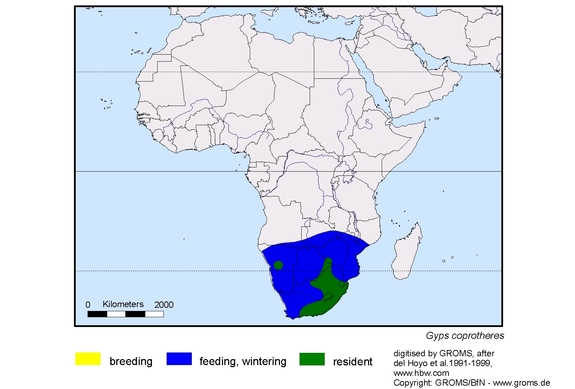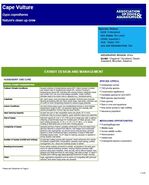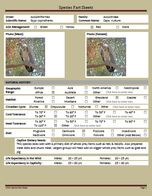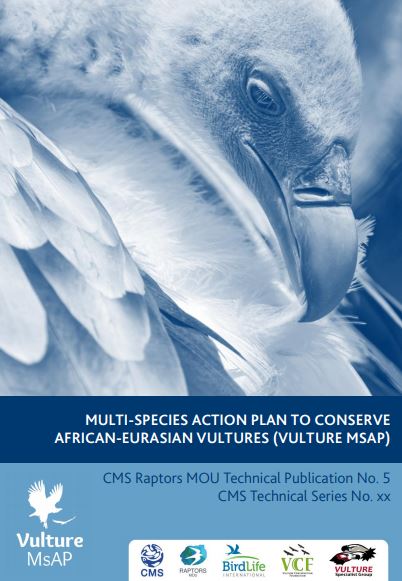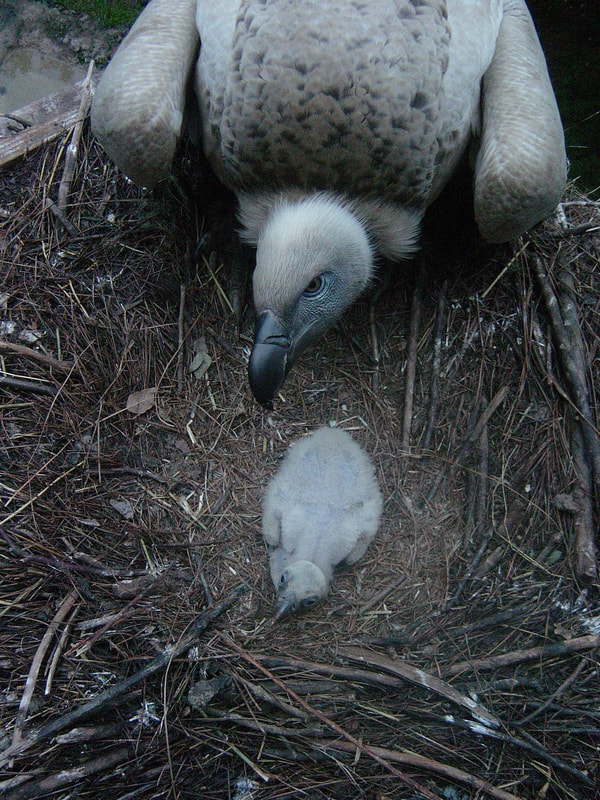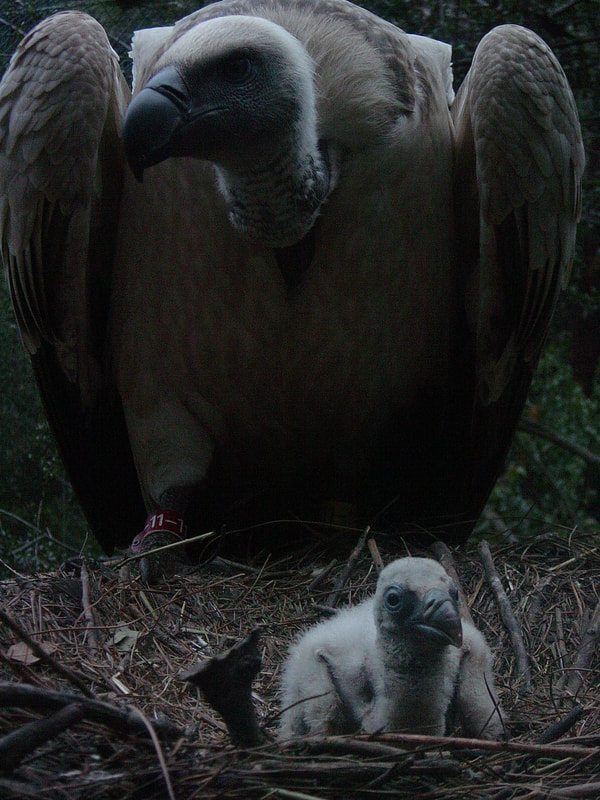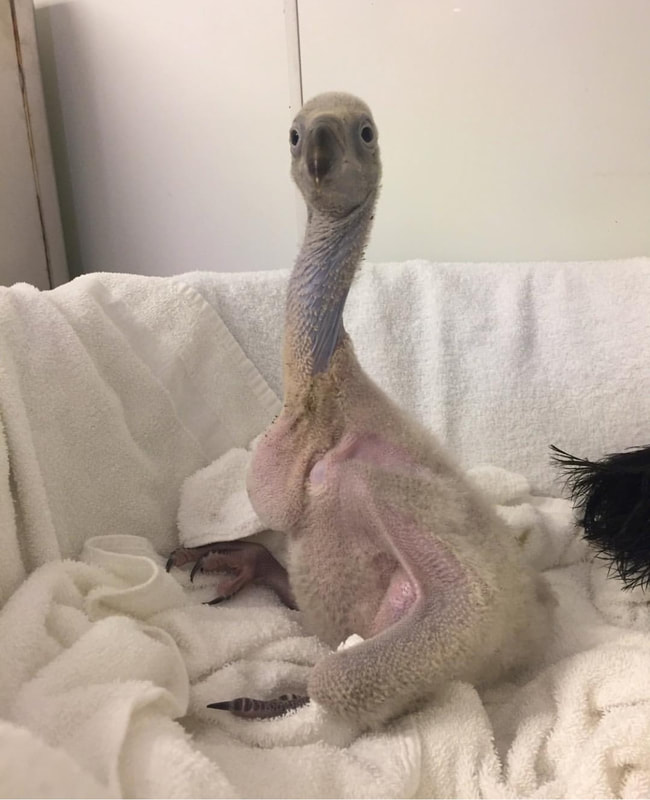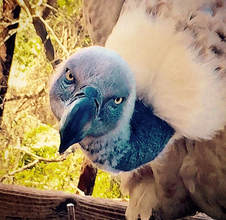Photo: Dewald Kleynhans, VulPro
-
Natural History
-
SSP
-
Organizations
-
Conservation Action
-
Photo Gallery
<
>
|
Introduction: This species is listed as Endangered as its population is declining rapidly, however, recent increases in parts of its South African range mean declines are not thought to be sufficiently strong to warrant listing as Critically Endangered. Its small population is likely to continue declining unless ongoing conservation efforts, including public awareness programms and supplementary feeding, as well as efforts to reduce the threat from powerlines, are successful.
|
Physical Characteristics
- This majestic bird is a member of the Old World vulture family (Accipitridae), and is found only in southern Africa.
- The average length of adult birds is about 96–115 cm (38–45 in) with a wingspan of 2.26–2.6 m (7.4–8.5 ft) and a body weight of 7–11 kg (15–24 lb).
- Adults can be distinguished by their honey-colored eyes and naked, bluish throat, whilst juveniles have brown eyes and a pink neck
- The species is among the largest raptors in Africa, next to the lappet-faced vulture. After the Himalayan griffon vulture and the cinereous vulture, the Cape vulture is the third largest Old World vulture.
- These birds are gregarious, feeding, roosting and breeding close to each other. The nesting colonies can hold up to 1000 pairs in cliffs.
- The Cape Vulture regularly baths in pools after feeding. The bare skin of head and neck allows it to clean easily the blood of the carcass.
|
Habitat and Range
Current cape vulture populations can be found in Angola, Botswana, Lesotho, Mozambique, South Africa, and Zimbabwe. Formerly, they could also be found in Namibia and Swaziland. Vagrants are occasionally recorded from the Democratic Republic of the Congo and Zambia.
|
Feeding & Behavior
- Carrion and bone fragments of larger carcasses, mainly soft muscle and organ tissue
- Colonial and gregarious feeding with other vultures
- Feeds on a variety of wild carrion and livestock
Breeding
- The breeding season occurs between April and July.
- The Cape Vulture breeds in large colonies on cliff faces. The nest is a platform made with sticks and lined with dry grass carried in the bill. Both sexes build the nest.
- The female lays a single egg. The incubation lasts about 55 days, shared by both adults.
- At hatching, the chick is covered in white down.
- The parents take turns, as well to incubate as to care the chick which is fed by regurgitation mouth-to-mouth.
- The chick fledges about 140 days after hatching.
Conservation Issues
- They are now extinct as a breeding species in Namibia, Zimbabwe and Swaziland. There are approximately 10,000 individuals left and 4000 breeding pairs.
- Sixteen known or suspected mortality factors were identified and ranked at an expert workshop with a decrease in the amount of carrion (particularly during chick-rearing), inadvertent poisoning, electrocution on pylons or collision with cables, loss of foraging habitat and unsustainable harvesting for traditional uses considered the most important factors.
- A decrease in carnivores within the vulture’s range, due to farming activities, has also been blamed for causing skeleton abnormalities in chicks. Large carnivores would break up the bones of carcasses into small fragments, and the Cape vultures would feed these tiny fragments to the chicks as a source of calcium.
- In Namibia, mismanagement of rangelands has led to severe bush encroachment over large areas, and recent research has indicated that this has an adverse effect on their ability to find food
- A source of poisoning specific to many vultures, including the Cape vulture, is the drug diclofenac and related compounds, which is used to treat arthritis in cattle, and which leads to kidney failure in vultures who consume carcasses of treated cattle.
- Programs to raise awareness of the effect of poisons on the Cape vulture have been implemented by government and non-governmental organizations, and the national electricity supplier in South Africa has replaced pylons in some regions with a design that reduces the risk of electrocution to large birds.
- Feeding areas have been established, where food and bone flakes are provided for the Cape vultures and other scavenging birds. These ‘vulture restaurants’ have been successful in slowing population declines in some areas, increasing the chance of chicks surviving their first year
- Although the Cape Vulture has been the recipient of much conservation action, it is still declining. The Cape Vulture Task Force (CVTF) resolved to put in place a conservation program around each of the breeding colonies to try and halt this decline. The central aim of this program is to halt the decline in the population and to prevent the species’ range from further contracting.
|
Date of Last PVA/B&T Plan
6/9/2017 Current Population Size (N) 35 (17.18) Current Number of Participating AZA Member Institutions 7 Projected % GD at 100 years or 10 generations** 84.55% |
|
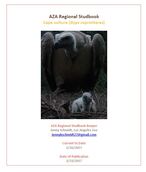
|
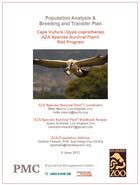
Population Analysis & Breeding and Transfer Plan
Cape Vulture (Gyps coprotheres) AZA Species Survival Plan® Red Program |
Officers
|
Name
|
Organization
|
Position
|
|
SSP Program Leader
|
|
Studbook Program Leader
|
|
Education Advisor
|
AZA SAFEThe African Vulture SAFE program is focusing on the conservation, restoration, and field research of the African vultures.
|
VulProVulPro’s work in South Africa involves instrumental veterinary toxicological research, colony monitoring, and rehabilitation of injured vultures. Additionally, VulPro breeds nonreleasable Cape Vultures, African White-backed Vultures, Lappet-faced Vultures, and White-headed Vultures as part of a conservation breeding and reintroduction program where all offspring are returned to the wild. Public education is also a large aspect of VulPro’s work, both to school groups and local communities as well as visiting researchers looking to gain invaluable field experience in areas such as capturing, tagging, monitoring and rescuing vultures.
VulPro is one of the organizations supported by African Vulture SAFE. |
AZA SAFEThe African Vulture SAFE program is focusing on the conservation, restoration, and field research of the African White-Backed vulture.
|
Multi-Species Action Plan to Conserve African-Eurasian Vultures (Vulture MSAP)This Multi-species Action Plan covers 15 of the 16 species classified as the Old World vultures, Palm-nut Vulture being excluded.
|
Photo credit Michael Clark; Los Angeles Zoo

